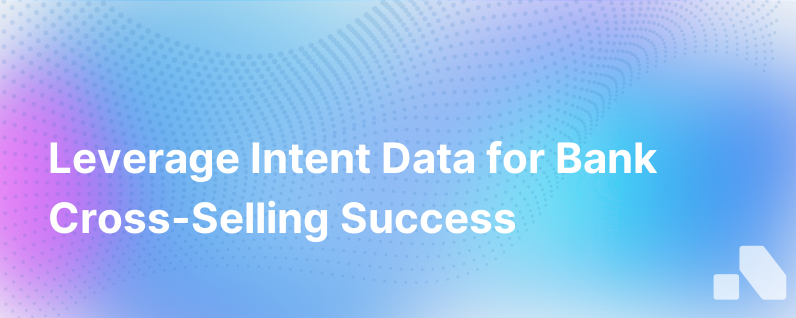
In the ever-evolving financial sector, banks are under continuous pressure to adapt to changing consumer demands, increasing competition from fintech startups, and complex regulatory environments. As the pace of innovation accelerates, data has emerged as the backbone of strategic decision-making. More specifically, intent data is revolutionizing how banks approach cross-selling – one of their primary revenue drivers.
Cross-selling, the practice of selling additional products or services to existing customers, is considerably more efficient than acquiring new customers. In fact, according to research by Bain & Company, it costs six to seven times more to acquire a new customer than to retain an existing one. For banks that can master the art of cross-selling by leveraging intent data, the rewards are substantial: stronger relationships, higher customer lifetime value (CLV), and a fortified competitive position.
Let’s unpack how banks can use intent data to boost cross-selling opportunities.
Understanding Intent Data
Intent data refers to the behavioral signals that individuals and organizations exhibit, indicating a potential interest in making a purchase decision. In the banking context, this could range from a customer researching mortgage rates online to a business displaying patterns of cash flow that suggest the need for a line of credit.
There are two primary types of intent data:
1. First-party intent data: Information that a bank collects directly from its interactions with the customer, such as website visits, mobile app usage, and interactions with online banking systems.
2. Third-party intent data: Insights gathered from external sources, including partner networks, public records, and social media activity that suggest an interest in specific financial products or services.
Why Intent Data Matters for Banks
In today’s information-rich world, customers expect personalized experiences that add value without feeling intrusive. Banks can utilize intent data to anticipate customer needs and present tailored cross-selling offers at the right time, through the right channels. A primary benefit of using intent data is that it reflects a genuine customer interest or need, which can drastically improve the success rate of cross-selling efforts.
Moreover, intent data provides banks with a competitive edge. By identifying signals earlier, a bank can engage customers before they even start shopping around. This preemptive approach can directly lead to improved retention rates while minimizing the opportunities for competitors to bid for your customers' business.
Strategies for Leveraging Intent Data in the Financial Industry
Personalized Product Recommendations
By analyzing first-party intent data, such as frequently visited product pages or inquiries sent to customer service, banks can personalize cross-selling efforts to individual customer behaviors and needs. For instance, if a customer often checks savings account rates or uses a savings goal calculator tool, a bank could promote their high-yield savings accounts or certificates of deposit as logical next steps.
Targeted Marketing Campaigns
With access to third-party intent data, banks can create granular customer segments for targeted marketing campaigns. A campaign could focus on customers who have recently browsed small business loan information on third-party industry sites. By aligning marketing messages with the customer’s demonstrated interests, banks can increase engagement rates and conversion.
Enhanced Customer Engagement
Understanding customer intent enables banks to tailor their engagement approach. For example, if intent data indicates that a customer may be interested in investment products, banks can initiate informative, soft-touch engagement through educational webinars, sending relevant articles, or scheduling advisory sessions with financial experts to build rapport and trust.
Predictive Analytics
Banks can harness intent data with artificial intelligence and machine learning algorithms to predict future customer behaviors and identify cross-selling opportunities before they might naturally arise. Predictive analytics can be used to recommend an auto loan to a customer who has shown recent online interest in automobile purchases or to suggest wealth management services to customers who are nearing retirement age.
Timely Follow-ups
Timing is crucial for successful cross-selling. By monitoring intent signals such as increased transaction volumes or modifications in deposit patterns, banks can proactively reach out to customers at moments when they are most likely to need additional services, enhancing the customer experience and increasing cross-selling opportunities.
Improving Customer Retention
Cross-selling isn’t just about the immediate sale. By using intent data to provide valuable offerings and advice, banks can deepen customer relationships and increase retention. A satisfied customer who feels understood and well-served is far more likely to stay with a bank, reducing churn and promoting long-term revenue growth.
Optimize Sales Force Performance
Armed with insights from intent data, sales teams can prioritize their outreach, focusing their efforts on prospects with the highest likelihood of needing additional products. They can tailor their communication strategies to be more consultative and relevant, ultimately closing more deals and achieving better outcomes.
Conclusion
The strategic use of intent data has the potential to revolutionize how banks approach cross-selling, shifting the paradigm from one that's sales-driven to one that’s customer-centric. Aligning products with real-time customer needs not only improves the success rate of cross-selling but also enriches the customer relationship, which is the foundation of any financial institution’s success.
For banks willing to invest in analytics and intent data platforms, the future is promising. Harnessing intent data to inform cross-selling strategies enables banks to operate more efficiently, compete more effectively, and serve their customers better, securing their position in a rapidly transforming marketplace.